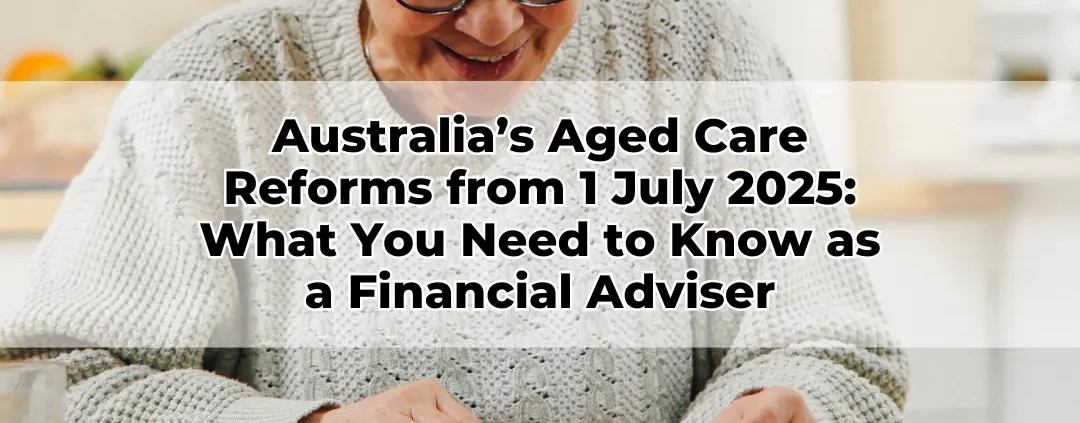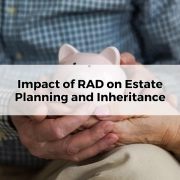Australia’s Aged Care Reforms from 1 July 2025: What You Need to Know as a Financial Adviser
Table of Contents
ToggleSignificant changes are on the horizon for Australia’s aged care system, with the new Aged Care Act coming into effect on 1 July 2025. These reforms aim to enhance the quality, fairness, and sustainability of aged care services by prioritizing the rights and needs of older Australians. As a financial adviser, understanding these changes is essential to guide clients entering aged care or planning for it in the future.
This article provides a comprehensive overview of the key reforms, focusing on what they mean for aged care residents and the financial strategies required to adapt to the evolving landscape.
The Introduction of the New Aged Care Act
The Aged Care Act 2024, passed on 25 November 2024, replaces outdated legislation to establish a more rights-focused and person-centered approach to aged care. This new Act introduces:
- A rights-based framework to empower older Australians, giving them greater control over their care.
- Stronger regulatory oversight to improve care standards and ensure providers are accountable.
- Clearer eligibility processes and a more streamlined system for accessing aged care services.
For financial advisers, this reform means paying closer attention to how the system assesses and funds care services for clients, as well as staying informed about clients’ rights to ensure they can access the best options available.
Objectives of the New Legislation
The Aged Care Act 2024 focuses on several key goals:
- Empowering Care Recipients: Older Australians will have increased autonomy in decision-making regarding their care.
- Improving Quality of Care: Strengthened Aged Care Quality Standards will ensure that services meet higher benchmarks of safety, dignity, and support.
- Ensuring Fairness: Reforms to means testing and contributions aim to balance individual and government funding fairly.
- Enhancing Provider Accountability: Stricter oversight mechanisms will require providers to meet new transparency standards.
Changes to Residential Aged Care Fees
The fee structure for residential aged care will undergo significant adjustments, affecting how accommodation and care costs are calculated and paid.
Accommodation Payments
-
Refundable Accommodation Deposit (RAD) Retention
From 1 July 2025, aged care providers will retain 2% of a resident’s RAD annually for up to five years. This means that residents could lose up to 10% of their deposit over time, reducing the amount refunded to their estate or family upon exit. -
Indexation of Daily Accommodation Payments (DAPs)
For residents who choose to pay for accommodation via DAPs instead of a RAD, these payments will be indexed twice a year to reflect inflation. This ensures that providers receive payments aligned with rising costs but also increases the financial burden on residents over time. -
Increase in Maximum Accommodation Price
From 1 January 2025, the threshold for accommodation prices that providers can charge without seeking government approval will rise from $550,000 to $750,000. This cap will be indexed annually, creating higher upfront costs for families entering care.
Ongoing Care Fees
-
Hotelling Contribution
A new means-tested fee of up to $12.55 per day will be introduced to cover non-clinical services, including meals and accommodation. -
Non-Clinical Care Contribution (NCCC)
The NCCC will replace the existing means-tested care fee, with a daily maximum of $101.16. Importantly, a lifetime cap of $130,000 or a maximum contribution period of four years in residential care will apply.
Introduction of the Support at Home Program
Starting in July 2025, the Support at Home Program will replace the Home Care Packages and the Commonwealth Home Support Programme. This reform is designed to provide greater flexibility and personalization in home-based care.
Key Features of the Program:
- New Care Classifications: Care levels will range across eight ongoing classifications, tailored to varying needs, as well as two short-term categories for restorative and end-of-life care.
- Individualised Support: Older Australians will have access to tailored services designed to help them remain at home for longer, delaying or avoiding the transition to residential care.
This change creates opportunities for financial advisers to help clients explore cost-effective home care options while understanding their funding entitlements.
Revised Means Testing and Financial Contributions
The reforms place greater emphasis on means testing to ensure that individuals with higher financial resources contribute more to their aged care costs. Key changes include:
- Adjusted thresholds for determining who pays means-tested fees.
- Increased out-of-pocket costs for wealthier clients, while maintaining government support for those with fewer resources.
This shift necessitates proactive financial planning to help clients understand and prepare for their likely contributions under the new framework.
Enhanced Provider Accountability and Transparency
Under the new Act, aged care providers will be subject to stricter accountability measures. These include:
- Enhanced Quality Standards: Providers must meet updated benchmarks for care delivery.
- Increased Transparency: Providers are required to disclose detailed information about fees, staffing, and service quality to residents and families.
- Strengthened Oversight: The aged care regulator will have expanded powers to monitor and enforce compliance, ensuring consistent and high-quality care.
Implications for Financial Advisers
The reforms significantly impact financial advisers, particularly in helping clients navigate their options and make informed decisions about aged care.
Client Financial Assessments
Advisers must perform detailed financial analyses to determine how means testing will affect clients’ contributions to care fees. Understanding clients’ income, assets, and cash flow will be critical.
Strategic Planning
Timing is now a vital consideration. Advisers should evaluate whether clients should enter care before or after 1 July 2025, depending on their financial situation and the new fee structures.
Estate Planning
The RAD retention policy will reduce the amount refunded to estates, affecting inheritance planning. Advisers should review and adjust estate plans to account for this.
Exploring Home Care Options
The Support at Home Program offers a viable alternative for clients who wish to remain at home. Advisers can help clients compare costs, benefits, and funding options to determine the most suitable approach.
Conclusion
Australia’s aged care system is undergoing its most significant overhaul in decades. The reforms brought by the new Aged Care Act aim to create a more equitable, person-centered system. However, these changes also bring complexities that require careful navigation.
As a financial adviser, staying informed and proactive is key to helping clients prepare for the new landscape. By understanding the revised fee structures, means testing, and home care alternatives, you can provide clients with the strategies they need to manage aged care costs effectively and protect their financial well-being.
With 1 July 2025 fast approaching, now is the time to start discussing these changes with your clients to ensure they’re prepared for the road ahead.









